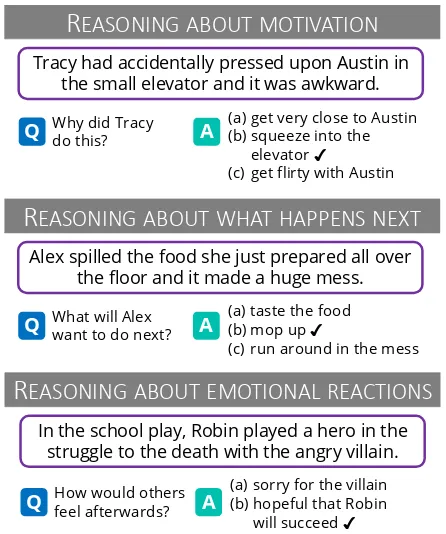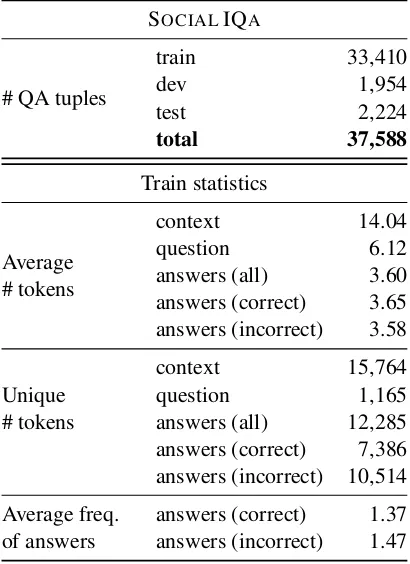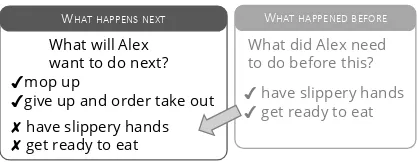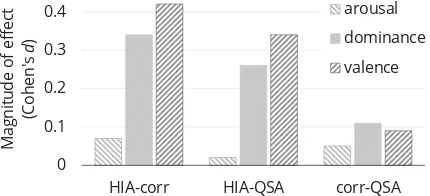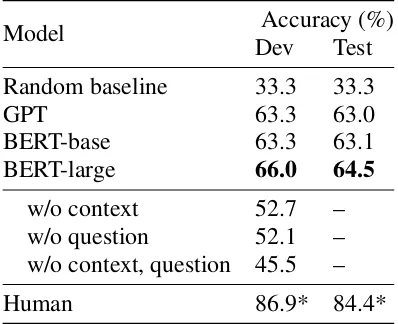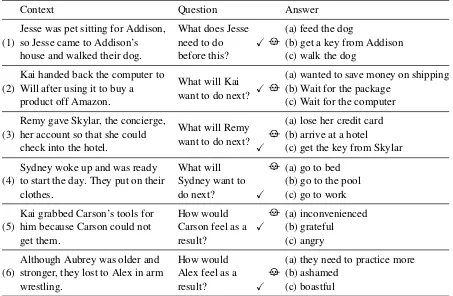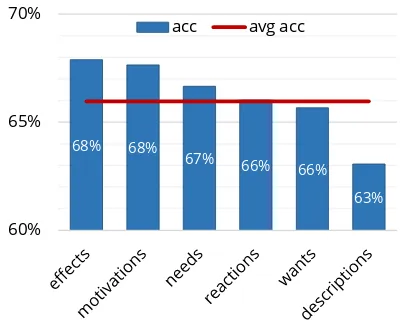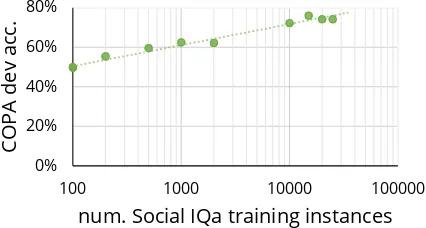Proceedings of the 2019 Conference on Empirical Methods in Natural Language Processing and the 9th International Joint Conference on Natural Language Processing, pages 4463–4473,
4463
SOCIAL
IQA: Commonsense Reasoning about Social Interactions
Maarten Sap? ♦♥ Hannah Rashkin?♦♥ Derek Chen♥ Ronan Le Bras♦ Yejin Choi♦♥ ♦Allen Institute for Artificial Intelligence, Seattle, WA, USA
♥Paul G. Allen School of Computer Science & Engineering, Seattle, WA, USA
{msap,hrashkin,dchen14,yejin}@cs.washington.edu
{ronanlb}@allenai.org
Abstract
We introduce SOCIALIQA, the first large-scale benchmark for commonsense reasoning about social situations. SOCIALIQAcontains 38,000 multiple choice questions for prob-ingemotionalandsocialintelligence in a va-riety of everyday situations (e.g., Q: “ dan wanted to tell Tracy a secret, so Jor-dan leaned towards Tracy. Why did JorJor-dan do this?” A: “Make sure no one else could hear”). Through crowdsourcing, we collect commonsense questions along with correct and incorrect answers about social interac-tions, using a new framework that mitigates stylistic artifacts in incorrect answers by ask-ing workers to provide the right answer to a different but related question. Empirical re-sults show that our benchmark is challenging for existing question-answering models based on pretrained language models, compared to human performance (>20% gap). Notably, we further establish SOCIALIQA as a re-source for transfer learning of commonsense knowledge, achieving state-of-the-art perfor-mance on multiple commonsense reasoning tasks (Winograd Schemas, COPA).
1 Introduction
Social and emotional intelligence enables humans to reason about the mental states of others and their likely actions (Ganaie and Mudasir, 2015). For example, when someone spills food all over the floor, we can infer that they will likely want to clean up the mess, rather than taste the food off the floor or run around in the mess (Figure1, middle). This example illustrates how Theory of Mind, i.e., the ability to reason about the implied emotions and behavior of others, enables humans to nav-igate social situations ranging from simple con-versations with friends to complex negotiations in courtrooms (Apperly,2010).
?Both authors contributed equally.
R
EASONING ABOUT WHAT HAPPENS NEXT(a) taste the food (b) mop up ✔
(c) run around in the mess What will Alex
want to do next? A
Alex spilled the food she just prepared all over the floor and it made a huge mess.
Q
R
EASONING ABOUT EMOTIONAL REACTIONS(a) sorry for the villain (b) hopeful that Robin
will succeed ✔ (c) like Robin should lose How would others
feel afterwards?
In the school play, Robin played a hero in the struggle to the death with the angry villain.
A Q
R
EASONING ABOUT MOTIVATIONWhy did Tracy do this?
Tracy had accidentally pressed upon Austin in the small elevator and it was awkward.
(a) get very close to Austin (b) squeeze into the
elevator ✔
(c) get flirty with Austin
[image:1.595.305.528.220.487.2]A Q
Figure 1: Three context-question-answers triples from SOCIALIQA, along with the type of reasoning required to answer them. In the top example, humans can triv-ially infer that Tracy pressed upon Austin because there was no room in the elevator. Similarly, in the bottom example, commonsense tells us that people typically root for the hero, not the villain.
2015; Nematzadeh et al., 2018; Talmor et al., 2019). This is partly due to language models being trained on written text corpora, where reporting bias of knowledge limits the scope of common-sense knowledge that can be learned (Gordon and Van Durme,2013;Lucy and Gauthier,2017).
In this work, we introduce Social Intelligence QA (SOCIALIQA), the first large-scale resource to learn and measure social and emotional intel-ligence in computational models.1 SOCIALIQA
contains 38k multiple choice questions regard-ing the pragmatic implications of everyday, social events (see Figure1). To collect this data, we de-sign a crowdsourcing framework to gather con-texts and questions that explicitly address social commonsense reasoning. Additionally, by com-bining handwritten negative answers with adver-sarial question-switched answers (Section3.3), we minimize annotation artifacts that can arise from crowdsourcing incorrect answers (Schwartz et al., 2017;Gururangan et al.,2018).
This dataset remains challenging for AI sys-tems, with our best performing baseline reaching 64.5% (BERT-large), significantly lower than hu-man perforhu-mance. We further establish SOCIAL
IQA as a resource that enables transfer learning for other commonsense challenges, through se-quential finetuningof a pretrained language model on SOCIALIQA before other tasks. Specifically, we use SOCIALIQA to set a new state-of-the-art
on three commonsense challenge datasets: COPA (Roemmele et al., 2011) (83.4%), the original Winograd (Levesque, 2011) (72.5%), and the ex-tended Winograd dataset from Rahman and Ng (2012) (84.0%).
Our contributions are as follows: (1) We cre-ate SOCIALIQA, the first large-scale QA dataset aimed at testing social and emotional intelligence, containing over 38k QA pairs. (2) We introduce question-switching, a technique to collect incor-rect answers that minimizes stylistic artifacts due to annotator cognitive biases. (3) We establish baseline performance on our dataset, with BERT-large performing at 64.5%, well below human per-formance. (4) We achieve new state-of-the-art ac-curacies on COPA and Winograd through sequen-tial finetuning on SOCIALIQA, which implicitly endows models with social commonsense knowl-edge.
1Available athttps://tinyurl.com/socialiqa
SOCIALIQA
# QA tuples
train 33,410
dev 1,954
test 2,224
total 37,588
Train statistics
Average # tokens
context 14.04
question 6.12
answers (all) 3.60
answers (correct) 3.65 answers (incorrect) 3.58
Unique # tokens
context 15,764
question 1,165
answers (all) 12,285 answers (correct) 7,386 answers (incorrect) 10,514
Average freq. of answers
[image:2.595.314.519.63.345.2]answers (correct) 1.37 answers (incorrect) 1.47
Table 1: Data statistics for SOCIALIQA.
2 Task description
SOCIALIQA aims to measure the social and emotional intelligence of computational models through multiple choice question answering (QA). In our setup, models are confronted with a ques-tion explicitly pertaining to an observed context, where the correct answer can be found among three competing options.
By design, the questions requireinferential rea-soning about the social causes and effects of situa-tions, in line with the type of intelligence required for an AI assistant to interact with human users (e.g., know to call for help when an elderly per-son falls; Pollack, 2005). As seen in Figure 1, correctly answering questions requires reasoning about motivations, emotional reactions, or likely preceding and following actions. Performing these inferences is what makes us experts at navigat-ing social situations, and is closely related to The-ory of Mind, i.e., the ability to reason about the beliefs, motivations, and needs of others ( Baron-Cohen et al., 1985).2 Endowing machines with this type of intelligence has been a longstanding but elusive goal of AI (Gunning,2018).
2Theory of Mind is well developed in most neurotypical
ATOMIC
As a starting point for our task creation, we draw upon social commonsense knowledge from ATOMIC (Sap et al., 2019) to seed our contexts and question types. ATOMIC is a large knowledge graph that contains inferential knowledge about the causes and effects of 24k short events. Each triple in ATOMIC consists of an event phrase with person-centric variables, one of nine inference di-mensions, and an inference object (e.g., “PersonX pays for PersonY’s ”, “xAttrib”, “generous”). The nine inference dimensions in ATOMIC cover causes of an event (e.g., “X needs money”), its ef-fects on the agent (e.g., “X will get thanked”) and its effect on other participants (e.g., “Y will want to see X again”); seeSap et al.(2019) for details.
Given this base, we generate natural language contexts that represent specific instantiations of the event phrases found in the knowledge graph. Furthermore, the questions created probe the com-monsense reasoning required to navigate such contexts. Critically, since these contexts are based off of ATOMIC, they explore a diverse range of motivations and reactions, as well as likely pre-ceding or following actions.
3 Dataset creation
SOCIALIQA contains 37,588 multiple choice questions with three answer choices per question. Questions and answers are gathered through three phases of crowdsourcing aimed to collect the con-text, thequestion, and a set ofpositiveandnegative
answers. We run crowdsourcing tasks on Ama-zon Mechanical Turk (MTurk) to create each of the three components, as described below.
3.1 Event Rewriting
In order to cover a variety of social situations, we use the base events from ATOMIC as prompts for context creation. As a pre-processing step, we run an MTurk task that asks workers to turn an ATOMIC event (e.g., “PersonX spills all over the floor”) into a sentence by adding names, fixing potential grammar errors, and filling in placehold-ers (e.g., “Alex spilled food all over the floor.”).3
3.2 Context, Question, & Answer Creation
Next, we run a task where annotators create full context-question-answers triples. We auto-matically generate question templates covering
3This task paid $0.35 per event.
Alex spilt food all over the floor and it made a huge mess.
What will Alex want to do next?
WHAT HAPPENS NEXT
What did Alex need to do before this? ✔mop up
✔give up and order take out
✘have slippery hands
✘get ready to eat
✔have slippery hands
✔get ready to eat
[image:3.595.312.521.85.166.2]WHAT HAPPENED BEFORE
Figure 2: Question-Switching Answers (QSA) are col-lected as the correct answers to the wrong question that targets a different type of inference (here, reasoning about what happens before instead of after an event).
the nine commonsense inference dimensions in ATOMIC.4 Crowdsourcers are prompted with an event sentence and an inference question to turn into a more detailed context5 (e.g. “Alex spilled food all over the floor and it made a huge mess.”) and an edited version of the question if needed for improved specificity (e.g. “What will Alex want to do next?”). Workers are also asked to contribute two potential correct answers.
3.3 Negative Answers
In addition to correct answers, we collect four in-correct answer options, of which we filter out two. To create incorrect options that are adversarial for models but easy for humans, we use two different approaches to the collection process. These two methods are specifically designed to avoid differ-ent types of annotation artifacts, thus making it more difficult for models to rely on data biases. We integrate and filter answer options and validate final QA tuples with human rating tasks.
Handwritten Incorrect Answers (HIA) The
first method involves eliciting handwritten incor-rect answers that require reasoning about the con-text. These answers are handwritten to be similar to the correct answers in terms of topic, length, and style but are subtly incorrect. Two of these answers are collected during the same MTurk task as the original context, questions, and correct an-swers. We will refer to these negative responses as handwritten incorrect answers (HIA).
Question-Switching Answers (QSA) We
col-lect a second set of negative (incorrect) answer
4
We do not generate templates if the ATOMIC dimension is annotated as “none.”
5Workers were asked to contribute a context 7-25 words
ZDQWV
(e.g., What will Kai want to do next?)
UHDFWLRQV
(e.g., How would Robin feel afterwards?)
GHVFULSWLRQV
(e.g., How would you describe Alex?)
PRWLYDWLRQV
(e.g., Why did Sydney do this?)
QHHGV
(e.g., What does Remy need to do before this?)
HIIHFWV
(e.g., What will happen to
[image:4.595.86.526.64.114.2]Sasha?)
Figure 3: SOCIALIQAcontains several question types which cover different types of inferential reasoning. Ques-tion types are derived from ATOMIC inference dimensions.
candidates by switching the questions asked about the context, as shown in Figure2. We do this to avoid cognitive biases and annotation artifacts in the answer candidates, such as those caused by writing incorrect answers or negations (Schwartz et al., 2017; Gururangan et al., 2018). In this crowdsourcing task, we provide the same context as the original question, as well as a question au-tomatically generated from a different but similar ATOMIC dimension,6 and ask workers to write two correct answers. We refer to these negative responses as question-switching answers (QSA).
By including answers to a different question about the same context, we ensure that these ad-versarial responses have the stylistic qualities of correct answers and strongly relate to the con-text topic, while still being incorrect, making it difficult for models to simply perform pattern-matching. To verify this, we compare valence, arousal, and dominance (VAD) levels across an-swer types, computed using the VAD lexicon by Mohammad (2018). Figure 4 shows effect sizes (Cohen’s d) of the differences in VAD means, where the magnitude of effect size indicates how different the answer types are stylistically. Indeed, QSA and correct answers differ substantially less than HIA answers (|d|≤.1).7
3.4 QA Tuple Creation
As the final step of the pipeline, we aggregate the data into three-way multiple choice questions. For each created context-question pair contributed by crowdsourced workers, we select a random cor-rect answer and the incorcor-rect answers that are least entailed by the correct one, following inspiration fromZellers et al.(2019a).
For the training data, we validate our QA tu-ples through a multiple-choice crowdsourcing task where three workers are asked to select the right
6Using the following three groupings of ATOMIC
dimen-sions: {xWant, oWant, xNeed, xIntent}, {xReact oReact, xAttr}, and{xEffect, oEffect}.
7Cohen’s |d|<.20 is considered small (Sawilowsky,
2009). We find similarly small effect sizes using other senti-ment/emotion lexicons.
0 0.1 0.2 0.3 0.4
HIA-corr HIA-QSA corr-QSA
Ma
gn
itu
de o
f eff
ect
(C
oh
en
's
d
)
arousal dominance valence
Figure 4: Magnitude of effect sizes (Cohen’sd) when comparing average dominance, arousal and valence values of different answer types where larger |d| in-dicates more stylistic difference. For valence (senti-ment polarity) and dominance, the effect sizes compar-ing QSA and correct answers are much smaller, indi-cating that these are more similar tonally. Notably, all three answer types have comparable levels of arousal (intensity).
answer to the question provided.8 In order to en-sure even higher quality, we validate the dev and test data a second time with five workers. Our final dataset contains questions for which the correct answer was determined by human majority vot-ing, discarding cases without a majority vote. We also apply a lightweight form of adversarial filter-ing to make the task more challengfilter-ing by usfilter-ing a deep stylistic classifier to remove easier examples on the dev and test sets (Sakaguchi et al.,2019).9
To obtain human performance, we run a sepa-rate task asking three new workers to select the correct answer on a random subset of 900 dev and 900 test examples. Human performance on these subsets is 87% and 84%, respectively.
3.5 Data Statistics
To keep contexts separate across train/dev/test sets, we assign SOCIALIQA contexts to the same partition as the ATOMIC event the context was based on. Shown in Table 1 (top), this yields a
8Agreement on this task was high (Cohen’sκ=.70) 9We also tried filtering to remove examples from the
[image:4.595.309.524.172.270.2]total set of around 33k training, 2k dev, and 2k test tuples. We additionally include statistics on word counts and vocabulary of the training data. We report the averages of correct and incorrect an-swers in terms of: token length, number of unique tokens, and number of times a unique answer ap-pears in the dataset. Note that due to our three-way multiple choice setup, there are twice as many in-correct answers which influences these statistics.
We also include a breakdown (Figure3) across question types, which we derive from ATOMIC inference dimensions.10 In general, questions re-lating to what someone will feel afterwards or what they will likely do next are more common in SOCIALIQA. Conversely, questions pertaining to (potentially involuntary) effects of situations on people are less frequent.
4 Methods
We establish baseline performance on SOCIAL
IQA, using large pretrained language models based on the Transformer architecture (Vaswani et al., 2017). Namely, we finetune OpenAI-GPT (Radford et al., 2018) and BERT (Devlin et al., 2019), which have both shown remarkable im-provements on a variety of tasks. OpenAI-GPT is a uni-directional language model trained on the BookCorpus (Zhu et al.,2015), whereas BERT is a bidirectional language model trained on both the BookCorpus and English Wikipedia. As per pre-vious work, we finetune the language model rep-resentations but fully learn the classifier specific parameters described below.
Multiple choice classification To classify sequences using these language models, we follow the multiple-choice setup implementation by the respective authors, as described below. First, we concatenate the context, question, and answer, using the model specific separator tokens. For OpenAI-GPT, the format becomes start <context> <question> delimiter <answer> classify , where start ,
delimiter , and classify are special function tokens. For BERT, the format is similar, but the classifier token comes before the context.11 For each triple, we then compute a score l by
10We group agent and theme ATOMIC dimensions
to-gether (e.g., “xReact” and “oReact” become the “reactions” question type).
11BERT’s format is [CLS] <context> [UNUSED] <question> [SEP] <answer> [SEP]
Model Accuracy (%)
Dev Test
Random baseline 33.3 33.3
GPT 63.3 63.0
BERT-base 63.3 63.1
BERT-large 66.0 64.5
w/o context 52.7 –
w/o question 52.1 –
w/o context, question 45.5 –
[image:5.595.317.516.63.225.2]Human 86.9* 84.4*
Table 2: Experimental results. We additionally perform an ablation by removing contexts and questions, veri-fying that both are necessary for BERT-large’s perfor-mance. Human evaluation results are obtained using 900 randomly sampled examples.
passing the hidden representation from the classi-fier tokenhCLS ∈RH through an MLP:
l=W2tanh(W1hCLS +b1)
whereW1 ∈ RH×H,b1 ∈ RH andW2 ∈ R1×H.
Finally, we normalize scores across all triples for a given context-question pair using a softmax layer. The model’s predicted answer corresponds to the triple with the highest probability.
5 Experiments
5.1 Experimental Set-up
We train our models on the 33k SOCIALIQA train-ing instances, selecttrain-ing hyperparameters based on the best performing model on our dev set, for which we then report test results. Specifically, we perform finetuning through a grid search over the hyper-parameter settings (with a learning rate in
{1e−5,2e−5,3e−5}, a batch size in{3,4,8}, and a number of epochs in {3,4,10}) and report the maximum performance.
Models used in our experiments vary in sizes: OpenAI-GPT (117M parameters) has a hid-den size H=768, BERT-base (110M params) and BERT-large (340M params) hidden sizes of
H=768 and H=1024, respectively. We train us-ing the Huggus-ingFace PyTorch (Paszke et al.,2017) implementation.12
Context Question Answer
(1)
Jesse was pet sitting for Addison, so Jesse came to Addison’s house and walked their dog.
What does Jesse need to do before this?
(a) feed the dog
X (b) get a key from Addison (c) walk the dog
(2)
Kai handed back the computer to Will after using it to buy a product off Amazon.
What will Kai want to do next?
(a) wanted to save money on shipping
X (b) Wait for the package (c) Wait for the computer
(3)
Remy gave Skylar, the concierge, her account so that she could check into the hotel.
What will Remy want to do next?
(a) lose her credit card (b) arrive at a hotel
X (c) get the key from Skylar
(4)
Sydney woke up and was ready to start the day. They put on their clothes.
What will Sydney want to do next?
(a) go to bed (b) go to the pool
X (c) go to work
(5)
Kai grabbed Carson’s tools for him because Carson could not get them.
How would Carson feel as a result?
(a) inconvenienced
X (b) grateful (c) angry
(6)
Although Aubrey was older and stronger, they lost to Alex in arm wrestling.
How would Alex feel as a result?
(a) they need to practice more (b) ashamed
[image:6.595.73.526.63.359.2]X (c) boastful
Table 3: Example CQA triples from the SOCIALIQAdev set with BERT-large’s predictions ( : BERT’s predic-tion,X: true correct answer). The model predicts correctly in (1) and (2) and incorrectly in the other four examples shown here. Examples (3) and (4) illustrate the model choosing answers that might have happened before, or that might happen much later after the context, as opposed to right after the context situation. In Examples (5) and (6), the model chooses answers that may apply to people other than the ones being asked about.
5.2 Results
Our results (Table 2) show that SOCIALIQA is
still a challenging benchmark for existing com-putational models, compared to human perfor-mance. Our best performing model, BERT-large, outperforms other models by several points on the dev and test set. We additionally ablate our best model’s representation by removing the context and question from the input, confirming that rea-soning over both is necessary for this task.
Learning Curve To better understand the ef-fect of dataset scale on model performance on our task, we simulate training situations with lim-ited knowledge. We present the learning curve of BERT-large’s performance on the dev set as it is trained on more training set examples (Fig-ure5). Although the model does significantly im-prove over a random baseline of 33% with only a few hundred examples, the performance only starts to converge after around 20k examples, pro-viding evidence that large-scale benchmarks are required for this type of reasoning.
Error Analysis We include a breakdown of our best model’s performance on various question types in Figure6and specific examples of errors in the last four rows of Table3. Overall, questions related to pre-conditions of the context (people’s motivations, actions needed before the context) are less challenging for the model. Conversely, the model seems to struggle more with questions re-lating to (potentially involuntary) effects, stative descriptions, and what people will want to do next.
0% 20% 40% 60% 80% 100%
100 1000 10000 100000 1000000
de
v
acc
.
[image:7.595.76.288.61.190.2]num. training instances
Figure 5: Dev accuracy when training BERT-large with various number of examples (multiple runs per training size), with human performance (86.9%) shown in or-ange. In order to reach>80%, the model would require nearly 1 million training examples.
are incorrectly timed with respect to the context and question (e.g., “arrive at a hotel” is some-thing Remy likely did before checking in with the concierge, not afterwards). Additionally, the model often chooses answers related to a person other than the one asked about. In (6), after the arm wrestling, though it is likely that Aubrey will feel ashamed, the question relates to what Alex might feel–not Aubrey.
Overall, our results illustrate how reasoning about social situations still remains a challenge for these models, compared to humans who can triv-ially reason about the causes and effects for mul-tiple participants. We expect that this task would benefit from models capable of more complex rea-soning about entity state, or models that are more explicitly endowed with commonsense (e.g., from knowledge graphs like ATOMIC).
6 SOCIALIQAfor Transfer Learning
In addition to being the first large-scale bench-mark for social commonsense, we also show that SOCIALIQAcan improve performance on down-stream tasks that require commonsense, namely the Winograd Schema Challenge and the Choice of Plausible Alternatives task. We achieve state of the art performance on both tasks by sequentially finetuning on SOCIALIQAbefore the task itself.
COPA The Choice of Plausible Alternatives task (COPA; Roemmele et al., 2011) is a two-way multiple choice task which aims to measure commonsense reasoning abilities of models. The dataset contains 1,000 questions (500 dev, 500 test) that ask about the causes and effects of a premise. This has been a challenging task for
68% 68%
67% 66% 66%
63%
60% 65% 70%
[image:7.595.316.516.66.226.2]acc avg acc
Figure 6: Average dev accuracy of BERT-large on dif-ferent question types. While questions about effects and motivations are easier, the model still finds wants and descriptions more challenging.
computational systems, partially due to the limited amount of training data available. As done previ-ously (Goodwin et al.,2012;Luo et al.,2016), we finetune our models on the dev set, and report per-formance only on the test set.
Winograd Schema The Winograd Schema
Challenge (WSC; Levesque, 2011) is a well-known commonsense knowledge challenge framed as a coreference resolution task. It contains a collection of 273 short sentences in which a pronoun must be resolved to one of two antecedents (e.g., in “The city councilmen refused the demonstrators a permit because they
feared violence”, they refers to the councilmen). Because of data scarcity in WSC,Rahman and Ng (2012) created943Winograd-style sentence pairs (1886 sentences in total), henceforth referred to as DPR, which has been shown to be slightly less challenging than WSC for computational models. We evaluate on these two benchmarks. While the DPR dataset is split into train and test sets (Rahman and Ng, 2012), the WSC dataset con-tains a single (test) set of only273 instances for evaluation purposes only. Therefore, we use the DPR dataset as training set when evaluating on the WSC dataset.
6.1 Sequential Finetuning
Task Model Acc. (%) best mean std
COP
A Sasaki et al.(2017) 71.2 – –
BERT-large 80.8 75.0 3.0
BERT-SOCIALIQA 83.4 80.1 2.0
WSC
Kocijan et al.(2019) 72.5 – –
BERT-large 67.0 65.5 1.0
BERT-SOCIALIQA 72.5 69.6 1.7
DPR
Peng et al.(2015) 76.4 – –
BERT-large 79.4 71.2 3.8
[image:8.595.310.523.64.178.2]BERT-SOCIALIQA 84.0 81.7 1.2
Table 4: Sequential finetuning of BERT-large on SO -CIALIQAbefore the task yields state of the art results (bolded) on COPA (Roemmele et al.,2011), Winograd Schema Challenge (Levesque, 2011) and DPR (Rah-man and Ng,2012). For comparison, we include previ-ous published state of the art performance.
we report best, mean, and standard deviation of all models, and compare sequential finetuning results to a BERT-large baseline.
Results Shown in Table 4, sequential finetun-ing on SOCIALIQA yields substantial
improve-ments over the BERT-only baseline (between2.6 and5.5%max performance increases), as well as the general increase in performance stability (i.e., lower standard deviations). As hinted at byPhang et al. (2019), this suggests that BERT-large can benefit from both the large scale and the QA for-mat of commonsense knowledge in SOCIALIQA, which it struggles to learn from small benchmarks only. Notably, we find that sequentially finetuned BERT-SOCIALIQA achieves state-of-the-art re-sults on all three tasks, showing improvements of previous best performing models.13
Effect of scale and knowledge type To bet-ter understand these improvements in downstream task performance, we investigate the impact on COPA performance of sequential finetuning on less SOCIALIQAtraining data (Figure7), as well as the impact of the type of commonsense knowl-edge used in sequential finetuning. As expected, the downstream performance on COPA improves when using a model pretrained on more of SO
-CIALIQA, indicating that the scale of the dataset
13Note that OpenAI-GPT was reported to achieve 78.6%
on COPA, but that result was not published, nor discussed in the OpenAI-GPT white paper (Radford et al.,2018).
0% 20% 40% 60% 80%
100 1000 10000 100000
COP
A
de
v
acc
.
[image:8.595.80.285.65.232.2]num. Social IQa training instances
Figure 7: Effect of finetuning BERT-large on varying sizes of the SOCIALIQA training set on the dev ac-curacy of COPA. As expected, the more SOCIALIQA instances the model is finetuned on, the better the accu-racy on COPA.
is one factor that helps in the fine-tuning. How-ever, when using SWAG (a similarly sized dataset) instead of SOCIALIQA for sequential finetuning, the downstream performance on COPA is lower (76.2%). This indicates that, in addition to its large scale, the social and emotional nature of the knowledge in SOCIALIQAenables improvements
on these downstream tasks.
7 Related Work
Commonsense Benchmarks: Commonsense
benchmark creation has been well-studied by previous work. Notably, the WinoGrad Schema Challenge (WSC; Levesque, 2011) and the Choice Of Plausible Alternatives dataset (COPA; Roemmele et al.,2011) are expert-curated collec-tions of commonsense QA pairs that are trivial for humans to solve. Whereas WSC requires physical and social commonsense knowledge to solve, COPA targets the knowledge of causes and effects surrounding social situations. While both benchmarks are of high-quality and created by experts, their small scale (150 and 1,000 examples, respectively) poses a challenge for modern modelling techniques, which require many training instances.
More recently, Talmor et al. (2019) intro-duce CommonsenseQA, containing 12k multiple-choice questions. Crowdsourced using Concept-Net (Speer and Havasi, 2012), these questions mostly probe knowledge related to factual and physical commonsense (e.g., “Where would I not want a fox?”). In contrast, SOCIALIQAexplicitly
Commonsense Knowledge Bases: In addition to large-scale benchmarks, there is a wealth of work aimed at creating commonsense knowledge repositories (Speer and Havasi, 2012; Sap et al., 2019;Zhang et al., 2017; Lenat, 1995;Espinosa and Lieberman, 2005;Gordon and Hobbs,2017) that can be used as resources in downstream rea-soning tasks. While SOCIALIQA is formatted as a natural language QA benchmark, rather than a taxonomic knowledge base, it also can be used as a resource for external tasks, as we have demon-strated experimentally.
Constrained or Adversarial Data Collection:
Various work has investigated ways to circumvent annotation artifacts that result from crowdsourc-ing. Sharma et al.(2018) extend the Story Cloze data by severely restricting the incorrect story end-ing generation task, reducend-ing the sentiment and negation artifacts. Rajpurkar et al.(2018) create an adversarial version of the extractive question-answering challenge, SQuAD (Rajpurkar et al., 2016), by creating 50k unanswerable questions. Instead of using humgenerated incorrect an-swers,Zellers et al.(2018,2019b) use adversarial filtering of machine generated incorrect answers to minimize surface patterns. Our dataset also aims to reduce annotation artifacts by using a multi-stage annotation pipeline in which we collect neg-ative responses from multiple methods including a unique adversarial question-switching technique.
8 Conclusion
We present SOCIALIQA, the first large-scale benchmark for social commonsense. Consisting of 38k multiple-choice questions, SOCIALIQA
covers various types of inference about people’s actions being described in situational contexts. We design a crowdsourcing framework for col-lecting QA pairs that reduces stylistic artifacts of negative answers through an adversarial question-switching method. Despite human performance of close to 90%, computational approaches based on large pretrained language models only achieve accuracies up to 65%, suggesting that these so-cial inferences are still a challenge for AI systems. In addition to providing a new benchmark, we demonstrate how transfer learning from SOCIAL
IQA to other commonsense challenges can yield
significant improvements, achieving new state-of-the-art performance on both COPA and Winograd Schema Challenge datasets.
Acknowledgments
We thank Chandra Bhagavatula, Hannaneh Ha-jishirzi, and other members of the UW NLP and AI2 community for helpful discussions and feedback throughout this project. We also thank the anonymous reviewers for their insight-ful comments and suggestions. This research was supported in part by NSF (IIS-1524371, IIS-1714566), DARPA under the CwC program through the ARO (W911NF-15-1-0543), DARPA under the MCS program through NIWC Pacific (N66001-19-2-4031), Samsung Research, and the National Science Foundation Graduate Research Fellowship Program under Grant No. DGE-1256082.
References
Ian Apperly. 2010. Mindreaders: the cognitive basis of” theory of mind”. Psychology Press.
Simon Baron-Cohen, Alan M Leslie, and Uta Frith. 1985. Does the Autistic Child have a “Theory of Mind”? Cognition, 21(1):37–46.
Ernest Davis and Gary Marcus. 2015. Commonsense reasoning and commonsense knowledge in artificial intelligence. Commun. ACM, 58:92–103.
Jacob Devlin, Ming-Wei Chang, Kenton Lee, and Kristina Toutanova. 2019. BERT: Pre-training of deep bidirectional transformers for language under-standing. InNAACL.
Jos´e H. Espinosa and Henry Lieberman. 2005. Event-net: Inferring temporal relations between common-sense events. InMICAI.
MY Ganaie and Hafiz Mudasir. 2015. A Study of So-cial Intelligence & Academic Achievement of Col-lege Students of District Srinagar, J&K, India. Jour-nal of American Science, 11(3):23–27.
Travis Goodwin, Bryan Rink, Kirk Roberts, and Sanda M Harabagiu. 2012. UTDHLT: Copacetic system for choosing plausible alternatives. In NAACL workshop on SemEval, pages 461–466. As-sociation for Computational Linguistics.
Andrew S Gordon and Jerry R Hobbs. 2017.A Formal Theory of Commonsense Psychology: How People Think People Think. Cambridge University Press.
Jonathan Gordon and Benjamin Van Durme. 2013. Re-porting bias and knowledge acquisition. In Proceed-ings of the 2013 Workshop on Automated Knowledge Base Construction, AKBC ’13, pages 25–30, New York, NY, USA. ACM.
Suchin Gururangan, Swabha Swayamdipta, Omer Levy, Roy Schwartz, Samuel R. Bowman, and Noah A. Smith. 2018. Annotation artifacts in nat-ural language inference data. InNAACL-HLT.
Vid Kocijan, Ana-Maria Cretu, Oana-Maria Camburu, Yordan Yordanov, and Thomas Lukasiewicz. 2019. A surprisingly robust trick for the winograd schema challenge. InACL.
Baris Korkmaz. 2011. Theory of mind and neurodevel-opmental disorders of childhood. Pediatr Res, 69(5 Pt 2):101R–8R.
Douglas B Lenat. 1995. Cyc: A large-scale investment in knowledge infrastructure. Communications of the ACM, 38(11):33–38.
Hector J. Levesque. 2011. The winograd schema chal-lenge. InAAAI Spring Symposium: Logical Formal-izations of Commonsense Reasoning.
Li Lucy and Jon Gauthier. 2017. Are distributional representations ready for the real world? evaluating word vectors for grounded perceptual meaning. In RoboNLP@ACL.
Zhiyi Luo, Yuchen Sha, Kenny Q Zhu, Seung-won Hwang, and Zhongyuan Wang. 2016. Common-sense causal reasoning between short texts. In Fif-teenth International Conference on the Principles of Knowledge Representation and Reasoning.
Gary Marcus. 2018. Deep learning: A critical ap-praisal.CoRR, abs/1801.00631.
Saif Mohammad. 2018. Obtaining reliable human rat-ings of valence, arousal, and dominance for 20,000 english words. In Proceedings of the 56th Annual Meeting of the Association for Computational Lin-guistics (Volume 1: Long Papers), pages 174–184.
Chris Moore. 2013. The development of commonsense psychology. Psychology Press.
Aida Nematzadeh, Kaylee Burns, Erin Grant, Alison Gopnik, and Thomas L. Griffiths. 2018. Evaluating theory of mind in question answering. InEMNLP.
Adam Paszke, Sam Gross, Soumith Chintala, Gre-gory Chanan, Edward Yang, Zachary DeVito, Zem-ing Lin, Alban Desmaison, Luca Antiga, and Adam Lerer. 2017. Automatic differentiation in pytorch. InNIPS-W.
Haoruo Peng, Daniel Khashabi, and Dan Roth. 2015. Solving hard coreference problems. In HLT-NAACL.
Jason Phang, Thibault F´evry, and Samuel R. Bowman. 2019. Sentence encoders on stilts: Supplementary training on intermediate labeled-data tasks. CoRR, abs/1811.01088.
Martha E. Pollack. 2005. Intelligent technology for an aging population: The use of ai to assist elders with cognitive impairment. AI Magazine, 26:9–24.
Alec Radford, Karthik Narasimhan, Tim Salimans, and Ilya Sutskever. 2018. Improving language under-standing by generative Pre-Training.
Altaf Rahman and Vincent Ng. 2012. Resolving complex cases of definite pronouns: The winograd schema challenge. In EMNLP, EMNLP-CoNLL ’12, pages 777–789, Stroudsburg, PA, USA. Asso-ciation for Computational Linguistics.
Pranav Rajpurkar, Robin Jia, and Percy Liang. 2018. Know what you don’t know: Unanswerable ques-tions for squad.arXiv preprint arXiv:1806.03822.
Pranav Rajpurkar, Jian Zhang, Konstantin Lopyrev, and Percy S. Liang. 2016. Squad: 100, 000+ questions for machine comprehension of text. InEMNLP.
Melissa Roemmele, Cosmin Adrian Bejan, and An-drew S. Gordon. 2011. Choice of plausible alter-natives: An evaluation of commonsense causal rea-soning. In AAAI Spring Symposium: Logical For-malizations of Commonsense Reasoning.
Keisuke Sakaguchi, Ronan Le Bras, Chandra Bhaga-vatula, and Yejin Choi. 2019. Winogrande: An adversarial winograd schema challenge at scale. ArXiv, abs/1907.10641.
Maarten Sap, Ronan Le Bras, Emily Allaway, Chan-dra Bhagavatula, Nicholas Lourie, Hannah Rashkin, Brendan Roof, Noah A Smith, and Yejin Choi. 2019. Atomic: An atlas of machine commonsense for if-then reasoning. InAAAI.
Shota Sasaki, Sho Takase, Naoya Inoue, Naoaki Okazaki, and Kentaro Inui. 2017. Handling multi-word expressions in causality estimation. InIWCS.
Shlomo S. Sawilowsky. 2009. New effect size rules of thumb. Journal of Modern Applied Statistical Meth-ods, 8(2):597–599.
Roy Schwartz, Maarten Sap, Ioannis Konstas, Li Zilles, Yejin Choi, and Noah A Smith. 2017. The effect of different writing tasks on linguistic style: A case study of the ROC story cloze task. InCoNLL.
Rishi Kant Sharma, James Allen, Omid Bakhshandeh, and Nasrin Mostafazadeh. 2018. Tackling the story ending biases in the story cloze test. InACL.
Robyn Speer and Catherine Havasi. 2012. Represent-ing general relational knowledge in conceptnet 5. In LREC.
Alon Talmor, Jonathan Herzig, Nicholas Lourie, and Jonathan Berant. 2019. CommonsenseQA: A ques-tion answering challenge targeting commonsense knowledge. InNAACL.
Rowan Zellers, Yonatan Bisk, Ali Farhadi, and Yejin Choi. 2019a. From recognition to cognition: Visual commonsense reasoning. InCVPR.
Rowan Zellers, Yonatan Bisk, Roy Schwartz, and Yejin Choi. 2018. SWAG: A large-scale adversar-ial dataset for grounded commonsense inference. In EMNLP.
Rowan Zellers, Ari Holtzman, Yonatan Bisk, Ali Farhadi, and Yejin Choi. 2019b. Hellaswag: Can a machine really finish your sentence? InACL.
Sheng Zhang, Rachel Rudinger, Kevin Duh, and Ben-jamin Van Durme. 2017. Ordinal common-sense in-ference. Transactions of the Association of Compu-tational Linguistics, 5(1):379–395.
